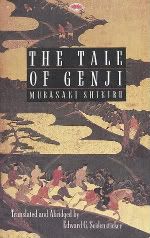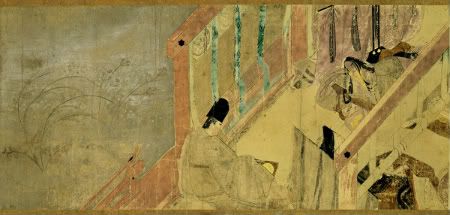 The Tale of Genji
The Tale of Genjiby Murasaki Shikibu

In the eleventh century Murasaki Shikibu, a lady in the Heian court of Japan, wrote the world's first novel. But The Tale of Genji is no mere artifact. It is, rather, a lively and astonishingly nuanced portrait of a refined society where every dalliance is an act of political consequence; a play of characters whose inner lives are as rich and changeable as those imagined by Proust. Cheif of these is "the shining Genji," the son of the emperor and a man whose passionate impulses create great turmoil in his world and very nearly destroy him. This edition, recognized as the finest version in English, contains a dozen chapters from early in the book, carefully chosen by the translator, Edward G. Seidensticker, with an introduction explaining the selection. It is illustrated throughout with woodcuts from a seventeenth-century edition.First Sentence:
In a certain reign there was a lady not of the first rank whom the emperor loved more than any of the others.
The Tale of Genji is a rare glimpse into eleventh century Japan. Murasaki Shikibu does a magnificent job describing the life at the imperial court. The story follows the life of Genji who is the son of the emperor, but his mother is of very low rank so he is unable to become an heir. Even though Genji cannot become an heir to the thrown he is the jewel of the imperial court, being talented in everything that was valued at the time including: poetry, dance, koto playing, and a keen eye for ascetics. Some could say that Genji is the equivalent of the European Renaissance man.
The good looks that the people at court thought would lead to Genji having a short life, proved to be wrong and ended up turning Genji into s true ladies man. Most of the story is consumed by Genji's affairs, which can be a bit tiresome and confusing. Genji chose some rather unexpected characters to become his lovers including a little girl that he brings to the palace to shape into the perfect wife. One good thing about all of Genji's affairs is it gives the reader the chance to read many different Waka, which are two lined poems that would be exchanged between lovers.
I would definitely recommend this book to anyone who is interested in Japanese history, since it is written by someone who lived during the Heian period. This book is also good for anyone who truly enjoys classics because it is considered one of the WORLD's first novels. However if you don't mind lengthy books, I would recommend reading the unabridged version which has 54 chapters compared to the 12 available in this version. One plus to the abridged version is it is full of woodblock printings inspired by the novel like the one below.

Historical Note:
Since women who lived at court were not allowed to learn Chinese they developed their own writting system known as Kana. Kana allowed them to express their feelings better than the traditional Chinese writting system because with Kana they could use Japanese words instead of finding a suitable word in the Chinese language. Women also had a lot of lesiure time that many used to perfect their writting. During the eleventh century women could not even visit others they had to wait until someone visited them, and if it was a male caller they had to communicate through a screen.
Title: The Tale of Genji
Author: Shikibu Murasaki
Paperback: 384 pages
ISBN 10: 0679729534
ISBN 13: 978-0679729534
Buy It: Amazon, Borders, Barnes & Noble
Review Number: 2





















1 comment:
It sounds like a great book -- and I have to say maybe the abridged sounds like it's for me: that wood cut is gorgeous. Maybe someday I'll go with the looooooong version!
Post a Comment